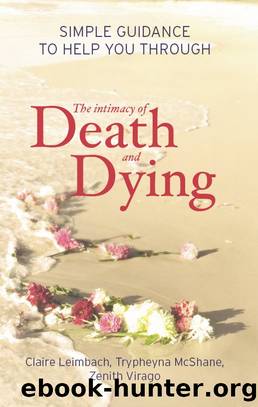The Intimacy of Death and Dying by Claire Leimbach Trypheyna McShane & Zenith Virago

Author:Claire Leimbach, Trypheyna McShane & Zenith Virago
Language: eng
Format: epub
Publisher: Allen & Unwin
Published: 2009-12-15T00:00:00+00:00
Helping our children with grief
As well as feeling your own pain when a loved one dies, thereâs the pain and empathy and bewilderment of the children to handle. How do we deal with death with our children, especially if itâs the death of someone close to them, such as their parent, brother, sister or friend. Itâs tempting to try to shield children from the pain of loss by excluding them from the experience of death. Many people think it is best for children not to see the body of the deceased, or even participate in their funeral. While this comes from the best intentions, it may actually do more harm than good.
Itâs important children are included in the process, and are treated with care and honesty. Keeping children away from death is robbing them of the opportunity to understand death and the precious memories it brings. Excluding them can cause lasting confusion, hurt and resentment.
Like adults, children also need to say goodbye to someone special, and to have a sense of completion. Just like us, they can only do this when they have the opportunity to be involved, and this includes visiting and being with the body of their loved one.
Research shows that allowing a child to be involved in the death offers them the opportunity to say goodbye in a tangible way. When they can honour the special person and relationship they shared, and express their feelings of loss and grief, it helps start the healing process, allowing them to adjust to the changes brought about by the loss.
When Jenniferâs children suffered the sudden loss of their energetic and fun-loving grandfather, with Zenithâs guidance they chose to create their own funeral. Roger was cherished in his community and many young children, along with Chloe, his three-year-old granddaughter, loved him. During the ceremony his body was laid out on a flat board rather than in a coffin, covered in silk, surrounded by flowers and placed on the floor to be easily accessible.
Young children aged between two and five helped place flowers around the man they remembered as a playful friend. They touched his face, felt his hands, then moved to a nearby table where they made drawings for him. The drawings were then placed with him in his coffin. As a result the children had the opportunity to discover for themselves that he was definitely dead, what âdeadâ felt like, and to say goodbye through their drawings. Their parents felt this was a healthy approach to death and bereavement.
Through their families and community, children need to learn about life and death. They often have an innate feeling for these natural life rhythms, and benefit from sensitive guidance, as they come to terms with the impermanence of life. Exposing them to animal deaths, for instance, as they occur can be an easier way for them to experience the reality of death. When we gently stay close to them, and allow them to be part of the process, children often lead us
Download
This site does not store any files on its server. We only index and link to content provided by other sites. Please contact the content providers to delete copyright contents if any and email us, we'll remove relevant links or contents immediately.
They Both Die at the End by Adam Silvera(9655)
Thirteen Reasons Why by Jay Asher(8716)
The Space Between by Michelle L. Teichman(6797)
Suicide Notes by Michael Thomas Ford(4691)
Tuesdays with Morrie by Mitch Albom(4566)
Suicide: A Study in Sociology by Emile Durkheim(2933)
The Checklist Manifesto by Atul Gawande(2716)
Tuesdays With Morrie by Mitch Albom(2609)
In the Woods by Tana French(2479)
Bossypants by Tina Fey(2403)
Robin by Dave Itzkoff(2278)
Olive Kitteridge by Elizabeth Strout(2256)
No Ashes in the Fire by Darnell L Moore(2236)
Reservoir 13 by Jon McGregor(2200)
Bus on Jaffa Road by Mike Kelly(2068)
All Things New by John Eldredge(2067)
End of Days by Sylvia Browne(2066)
Scar Tissue by Anthony Kiedis(2026)
No Time to Say Goodbye(2013)
